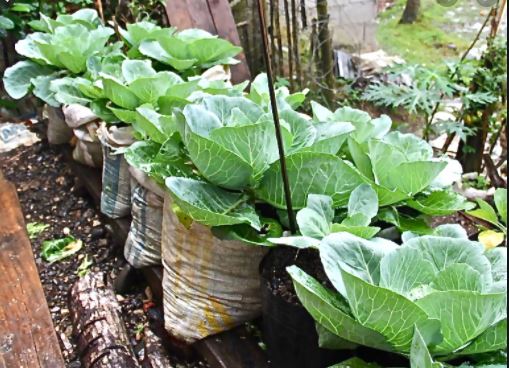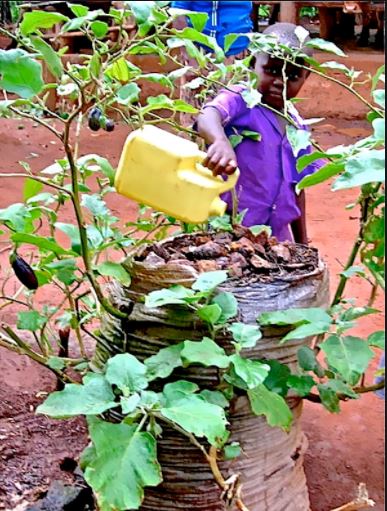
Did you know that through container gardening you can grow vegetables, fruits, and other plants in your compound, backyard, or veranda and you sell them for money?
As the world’s population grows, the demand for land for agriculture becomes higher and this has consequently created scarcity for agricultural space.
However, researchers from the Ministry of Agriculture, Animal Industry and Fisheries reveal that apart from greenhouses, the future of sustainable agriculture includes container gardening, whereby farmers use things like polythene bags, sack, buckets, pots, etc. to not only grow flowers but also edible plants and crops.
First things first; you only need a good container, the right soil mix, and appropriate seed (or transplant) varieties.
For instance, container gardening is an easy way to grow vegetables, especially when you lack garden space. If you don’t have even a small garden but you have a balcony, rooftop, verandah, or compound, explore the magical world of gardening in pots and other containers.
Tips for Container Gardening
Pots or Buckets: The Bigger, the Better
Large plants need lots of space, and most roots need room to grow. Avoid small containers as they often can’t store enough water to get through hot days. Plus, the bigger your container, the more plants you can grow!
Use barrels (a wooden half-barrel or plastic drum can yield an amazing amount of food), buckets, baskets, boxes, bath- and other tubs, and troughs—anything that holds soil. Just be sure that it has drainage holes in the bottom.

Clay pots are usually more attractive than plastic ones, but plastic pots retain moisture better and won’t dry out as fast as unglazed clay ones. To get the best of both, slip a plastic pot into a slightly larger clay pot. Black pots absorb heat when they are sitting in the sun.
Watering Is Key
Many plants grown in pots must be watered as often as twice a day. To keep plants adequately cool and moist during hot summer days, double-pot: Place a small pot inside a larger one and fill the space between them with sphagnum moss or crumpled newspaper. When watering the plant, also soak the filler between the pots.
Hanging baskets make good use of extra space, and herbs, cherry tomatoes, and strawberries that are grown at eye level can be easily tended and harvested.

Add about 1 inch of loam soil in the bottom of containers to improve drainage.
Vegetables that can be easily transplanted are best suited for containers. Transplants can be purchased from local nurseries or started at home.
Feed container plants at least twice a month with liquid fertilizer, following the instructions on the label.
An occasional application of fish emulsion or compost manure will add trace elements to container soil.
Place containers where they will receive maximum sunlight and good ventilation. Watch for and control insect pests.
Also Read: NAADS to Construct Pineapple Juice Factory for Kalangala Farmers
Window Boxes
A large window box can provide the makings for vegetables within arm’s reach! Whatever the size or type, place your containers where they are most convenient to be cared for and will grow best. Most vegetables need 6 to 8 hours of direct sun in order to thrive and produce well.
Mind The Spoil
Plants in containers need the best possible soil, aeration, and drainage for healthy root growth and optimum harvest. Do not use soil from the garden: It is too heavy, can become waterlogged, and brings disease and insects with it. Choose instead a soilless mix (quick-draining and lightweight) or use compost, alone or combined with a soilless mix.
To keep vegetable plants growing, feed them organic soil amendments, like liquid manure, fertilizers, fish emulsion, or weekly. To ensure growth, vegetables need consistently moist soil.
Plant Supports
Like people, plants need support. You can support your climbing vegetables with trellises, stakes, netting, twine, wire, or cages.
For instance, cucumbers or tomatoes trained to climb up a nylon mesh fence will develop fruit that hangs down and grow straight. To avoid damaging the plants or their roots, put supports in place at planting time.
To maximize space and thus your harvest, plant root crops, low-growers, and tall climbers together in the same container. The climbers will eagerly scramble up a trellis, while the small plants spread around their base. You’ll hardly need to weed because there won’t be any room for weeds to grow in your container.
Mix quick-maturing plants, such as Sukuma-Wik, Nakati, Dodo, green paper, or onions, with longer-growing ones, like tomatoes or carrots.
Group plants with similar needs for sun and water, such as pole beans, and lettuce; cucumber, bush beans, and beets; tomatoes, basil, and onions; and peas and carrots.
